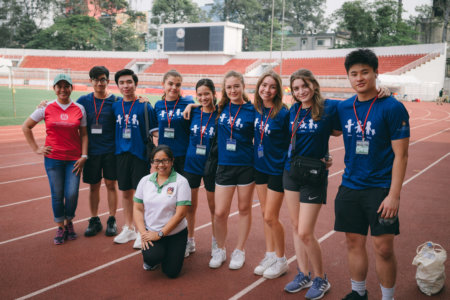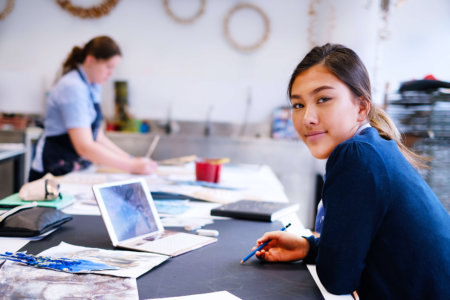
Long gone are the days where creativity in school was all about oil pastel paintings and playdough modelling. Today, a creative mindset is known to be critical in every thriving sector. A 2010 study by IBM — based on face-to-face conversations with more than 1,500 CEOs worldwide — highlighted creativity as “the single most important leadership competency” for enterprises seeking to thrive in “a global system of systems.”
Creativity is more than just coming up with something new or different. It is the basis for “disruptive innovation and continuous re-invention,” a Professional Services CEO in the United States told the report. Bold, breakthrough thinking, is a necessity, the CEOs elaborated.
A decade on, creativity remains one of the most sought-after soft skills. Last year, LinkedIn ranked it as the most in-demand soft skill across organisations.
Success often depends on how much exposure an individual has had to creative styles of thinking and learning. CEOs Shantanu Narayen, Susan Wojcicki and Reed Hastings were not born with the ideas to respectively innovate Adobe, YouTube and Netflix to success –– the right exposure gave them the necessary tools to spark social connections and create value with their brands.
The classroom is the perfect place to start emulating these icons — ideally in a 21st century school that understands the importance of diversity. Exposure to distinct, extraordinary cultures gives students the practice and confidence they need to springboard into international careers in the fields of their choosing.
International schools in the tiger economies of Singapore, South Korea, and Vietnam with significant expat communities are best placed to offer both innovation-led curricula and diversity. Here, inspiration abounds within and beyond campus walls. If you wish to give your child a student experience of a lifetime in one of these countries, here are three schools in Asia worth considering:
Tanglin Trust School
Founded in 1925, Tanglin Trust School is the oldest British International school in Southeast Asia. Fast forward nearly a century and it’s still leading the way as one of the region’s most innovative.
Here, 2,800 students representing over 50 nationalities benefit from a bespoke approach to curriculum development that ensures every child is engaged, challenged and motivated. The aim? To develop logical thinkers, creative whizzes and problem solvers who have transferable skills for careers that may not even exist today.

The Design and Technology department is the vanguard of creative teaching. Image source: Tanglin Trust School
Distinct offerings make this possible. The first is through the Design and Technology (D&T) department. Opened by Apple’s Head of Product Marketing for India and SEA — the D&T suite is set up to allow students the freedom to create through a variety of methods. It’s an exciting learning environment where they can tinker, engineer, design and manufacture hardware as well as software, using the latest technology to make something new.
“We have a laser cutter, vinyl cutter, 3D printers; there is the traditional machinery for timbers, polymers, and textiles; and then we have a CNC [computer numerical control] milling machine and a CNC router,” explains James Bleach, Head of D&T, who also designed the suite.
Tech-focused Film and Media studies offer aspiring Ang Lees and Christiane Amanpours everything they need to start building their oeuvres. This starts from as young as Junior School, where pupils make short films, explore production roles, compose shots, record sounds, edit in iMovie, and much more.
The Senior School takes things a step further. Here, students learn to read audio-visual media and to produce. In well-equipped facilities — including a Foley pit to design sound effects and soundtracks; a visual effects studio for adding motion graphics; a Google-style Think Tank pre-production room; two film studios with lighting rigs and professional cameras; and a 40-seat screening room — they get to apply what they learn, with no restriction in support or imagination. Masterclasses by industry figures — who have worked on award-winning films such as Lord of the Rings and Star Wars: The Force Awakens — complete the full Tanglin experience.
The result? A head start, lifelong friendships and exceptional academic results. To learn more about how Tanglin Trust School develops 21st century visionaries, learn more here.
Seoul Foreign School
Seoul Foreign School (SFS) in South Korea prepares students for the future of work by expanding students’ global outlook through an international curriculum and a diverse campus community. SFS offers the International Baccalaureate and the English National Curriculum.
The Elementary, Middle and High Schools offer the full IB programme. The British School at SFS provides English National Curriculum from Foundation to key stage three. Extensive fine arts, athletic, and student life programming are also offered here, ensuring students receive a well-rounded education.

Through the school’s drama, music and visual arts programmes, students are taught that education comes in many forms. Image source: Seoul Foreign School
One of its key unique features is its close-knit multicultural community. Despite being a Christian school, SFS is neither affiliated with a particular denomination nor with a particular church and does not have weekly chapels. The school welcomes students from all religious backgrounds, offering a real feeling of home to each and every student.
We have been ‘inspiring excellence and building character’ for over 100 years. Of the 6,000 international schools in the world, our legacy of achievement is one of the longest,” says Head of School Colm Flanagan.
“This is a community that goes the extra mile for its students. We work together to understand how we can help each learner fulfil his or her potential, setting them on the road to achieving their dreams.”
SFS’s dedication to sports can be seen through its athletic associations — with Asia Pacific Activities Conference, Korean-American Interscholastic Activities Conference, and Federation of British International Schools in Asia — and its participation in a variety of extracurricular activities such as volleyball, tennis, cross country, swimming, basketball, soccer, badminton and so forth.
Creativity is similarly emphasised. Through the school’s drama, music and visual arts programmes, students are taught that education comes in many forms — some of which include rhythm, movement and flair.
British International School Ho Chi Minh City
Established in 1997, the British International School Ho Chi Minh City has grown to become one of the largest international language schools in Vietnam. Students from age two to 18 are welcome at its campus where over 50 nationalities are represented. Average class size is 18 — the student to teacher ratio at the primary level is 21:2, secondary is 11:1.

BIS HCMC’s partnership with the Juilliard School enhances the learning of performing arts. Image source: British International School Ho Chi Minh City
BIS HCMC was the first school in Vietnam to be inspected and approved by the Association of British Schools Overseas. It is also officially awarded full accreditation status through the prestigious Council of International Schools (CIS) and a registered centre for the Cambridge International Examinations (CIE).
The school’s partnership with the Juilliard School enhances the learning of performing arts at BIS HCMC. Students get to explore core works of music, dance, and drama using teaching materials, creative activities, historical information, rehearsal strategies, and professional development — all designed by the prestigious conservatory.
BIS HCMC also collaborates with the world-renowned Massachusetts Institute of Technology (MIT) to provide a STEAM curriculum that tackles real-world challenges across the subjects of science, technology, engineering, art, and mathematics. This is how BIS HCMC students get to develop transferable skills such as flexibility, creativity, and communication.
“The wellbeing activities are enjoyable and help us to improve ourselves, such as our health when following the workout videos or our photography skills when participating in the daily photography challenge. Most importantly, the school has taught me to enjoy every moment in life,” said BIS HCMC student Marya Cao.
*Some of the institutions featured on this article are commercial partners of Study International










